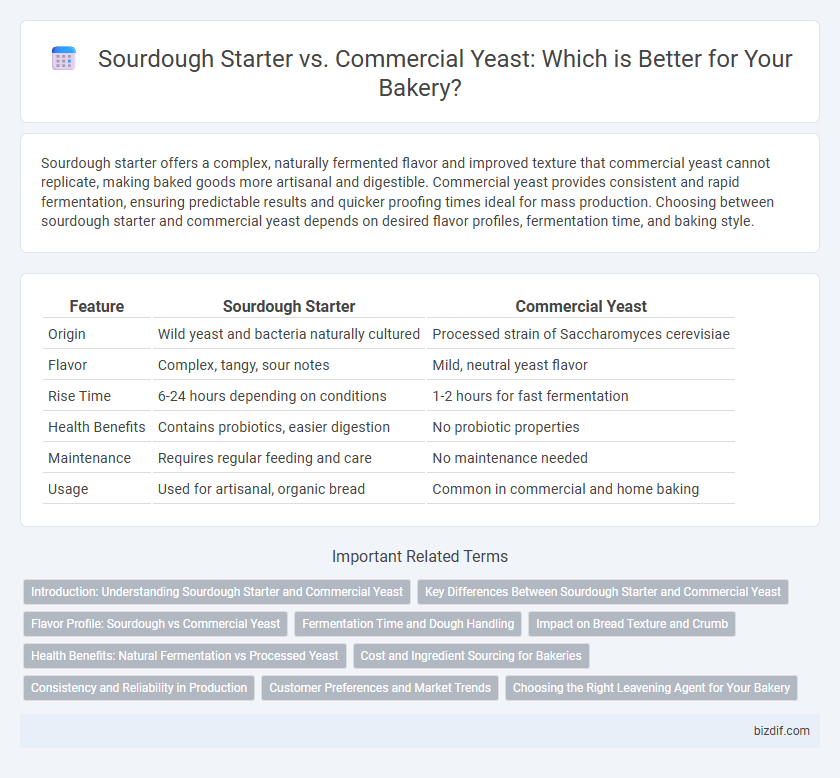Sourdough starter offers a complex, naturally fermented flavor and improved texture that commercial yeast cannot replicate, making baked goods more artisanal and digestible. Commercial yeast provides consistent and rapid fermentation, ensuring predictable results and quicker proofing times ideal for mass production. Choosing between sourdough starter and commercial yeast depends on desired flavor profiles, fermentation time, and baking style.
Table of Comparison
| Feature | Sourdough Starter | Commercial Yeast |
|---|---|---|
| Origin | Wild yeast and bacteria naturally cultured | Processed strain of Saccharomyces cerevisiae |
| Flavor | Complex, tangy, sour notes | Mild, neutral yeast flavor |
| Rise Time | 6-24 hours depending on conditions | 1-2 hours for fast fermentation |
| Health Benefits | Contains probiotics, easier digestion | No probiotic properties |
| Maintenance | Requires regular feeding and care | No maintenance needed |
| Usage | Used for artisanal, organic bread | Common in commercial and home baking |
Introduction: Understanding Sourdough Starter and Commercial Yeast
Sourdough starter, a natural fermenting agent made from wild yeast and lactic acid bacteria, offers complex flavors and improved digestibility in bread. Commercial yeast, typically Saccharomyces cerevisiae, provides rapid and consistent fermentation for predictable results in baking. Understanding the characteristics of both fermentation agents helps bakers choose the preferred method based on flavor, texture, and production needs.
Key Differences Between Sourdough Starter and Commercial Yeast
Sourdough starter consists of wild yeast and lactic acid bacteria, creating a natural fermentation process that enhances flavor and texture, while commercial yeast contains a single strain of Saccharomyces cerevisiae for consistent and rapid rising. The fermentation time for sourdough is longer, typically hours to days, compared to the quick proofing of commercial yeast, which usually takes less than two hours. Sourdough's complex microbial ecosystem contributes to improved digestibility and a tangy taste, whereas commercial yeast produces a more neutral flavor profile.
Flavor Profile: Sourdough vs Commercial Yeast
Sourdough starter develops a complex, tangy flavor profile due to natural lactic acid bacteria and wild yeast fermentation, creating depth and subtle acidity in baked goods. Commercial yeast produces a milder, more consistent taste with a slightly sweet and yeasty aroma, lacking the intricate sour notes found in sourdough. Bakers seeking robust, nuanced flavors often prefer sourdough starter for artisanal breads, while commercial yeast is favored for faster, reliable results.
Fermentation Time and Dough Handling
Sourdough starter requires longer fermentation times, often ranging from 12 to 48 hours, allowing natural wild yeast and lactic acid bacteria to develop complex flavors and improve dough texture. Commercial yeast ferments dough much faster, typically within 1 to 2 hours, enabling quicker bread production but with less nuanced taste. Dough handling for sourdough demands more attention to hydration and temperature control, whereas commercial yeast doughs are generally easier to manage and proof rapidly.
Impact on Bread Texture and Crumb
Sourdough starter produces bread with a complex, tangy flavor and a chewier, denser crumb due to natural fermentation and lactic acid bacteria activity, which enhances dough extensibility. Commercial yeast yields a lighter, softer texture with a more uniform crumb, resulting from rapid carbon dioxide production and shorter fermentation times. The choice between sourdough and commercial yeast significantly influences bread's moisture retention, crust thickness, and overall mouthfeel.
Health Benefits: Natural Fermentation vs Processed Yeast
Sourdough starter promotes natural fermentation, enhancing gut health through beneficial lactic acid bacteria and improved nutrient absorption. Commercial yeast, often processed and concentrated, lacks the probiotics found in sourdough, offering fewer digestive benefits. The natural fermentation in sourdough also reduces phytic acid, increasing mineral bioavailability and supporting overall nutritional value.
Cost and Ingredient Sourcing for Bakeries
Sourdough starters require minimal upfront cost, relying primarily on flour and water, making them highly cost-effective for bakeries committed to natural fermentation. Commercial yeast demands consistent purchasing, with costs influenced by supplier pricing and bulk quantities, but ensures predictable production timelines. Ingredient sourcing for sourdough is simpler and more sustainable, while commercial yeast depends on external suppliers, potentially increasing supply chain vulnerability.
Consistency and Reliability in Production
Sourdough starter offers unique flavor complexity but can vary significantly in activity due to factors such as temperature, hydration, and microbial balance, leading to less consistency in production. Commercial yeast provides predictable fermentation rates and uniform leavening power, ensuring reliable dough rise times and consistent product quality across batches. For large-scale bakeries aiming for standardized output, commercial yeast remains the preferred choice for operational stability.
Customer Preferences and Market Trends
Sourdough starters appeal to customers seeking artisanal, naturally fermented bread with complex flavors and health benefits, driving a growing market trend towards organic and traditional baking methods. Commercial yeast remains popular for its consistency, faster fermentation, and ease of use, catering to bakeries prioritizing efficiency and mass production. Consumer preferences are increasingly favoring sourdough for its authenticity, while commercial yeast dominates large-scale retail bakery operations.
Choosing the Right Leavening Agent for Your Bakery
Sourdough starter offers a complex flavor profile and natural fermentation benefits, ideal for artisanal breads requiring extended proofing times. Commercial yeast provides consistent rise times and predictable results, making it suitable for high-volume production and fast turnarounds. Selecting the right leavening agent depends on bakery goals, balancing flavor complexity with production efficiency.
Sourdough starter vs Commercial yeast Infographic

 bizdif.com
bizdif.com